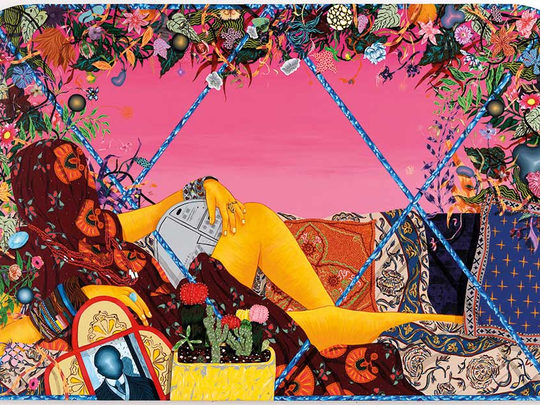
In his latest exhibition in Dubai, Almost Home, Amir H. Fallah delves into his own experience as an Iranian-American to reflect on the idea of home, of belonging outside one’s country of origin, and existing away from the homeland.
The show features a series of portraits of Iranian-American immigrants, depicted as anonymous figures identified only by their belongings, linked to their Iranian heritage or memories of Iran. In his signature style, the artist has used a bright palette and embellished each painting with a border of floral patterns, inspired by Persian rugs and miniatures.
Since many of the people in his portraits cannot travel to Iran, the artist has added another layer to the narrative by exhibiting the works in Dubai, a place that is ‘almost home’ for most Iranians.
“On my first visit to Dubai in 2005, I was invited to a party by a Dubai based Iranian friend. The guests included people from various countries in the region, and I suddenly realised that I could totally blend in, and be invisible in that group of brown skinned people. It was an amazing feeling because growing up in the US, the colour of my skin always made me stick out. Although I grew up in Los Angeles, and I feel American, in the US I am constantly being asked where I am really from. That moment in Dubai has stayed in my mind, and has made me think about the idea of home, and the fact that despite being born in Iran, that is not home for me; and although technically the US is home, I feel like an outsider there. However, I have never lived in Dubai, but whenever I visit the city, it feels like home, not just because of the large number of Iranians living here, and its proximity to Iran, but also because it embraces my own feeling of being a citizen of the world. This sense of Dubai being ‘almost home’ is an important part of this exhibition,” Fallah says.
Above left: Hold On To The Light, 2017; and Happiest Place On Earth, 2017
The people in his portraits are Iranian-American immigrants, who either chose to leave Iran, or were forced to leave the country and cannot ever return. The artist has concealed their identities, depicting them instead through the things they surround themselves with such as pieces of jewellery or clothes, objects and artifacts in their homes, and elements reflecting their work or interests.
“These works are about longing for home, and I have addressed the idea of home both as a birthplace or place of origin, and as a domestic space. Instead of their physical features I have depicted my subjects through the objects in their home that mean something to them. For this I visited their homes, and spent time talking to them, to understand what keeps them connected to their Iranian identity. The floral borders around each portrait refer to Persian rugs, which you will find in every Iranian home. But, rather than replicating the traditional borders, I have created a more organic, diluted reference to them that represents a memory of the original,” Fallah says.
In a final witty touch, the artist has painted on the walls of the gallery a Farsi translation of the lyrics of the number Homeward Bound by Simon and Garfunkel.
“I cannot read and write Farsi, and like a lot of my Iranian-American friends, I find it very frustrating to make sense of Google Translate’s translations of the messages posted by friends or family in Farsi. This song, which romanticises the idea of home, is an iconic piece of American pop culture, but this Farsi translation by Google Translate makes no sense, and the beauty of the lyrics has been lost. Like my paintings, this represents a deconstruction of the longing for home, and quite literally reflects my subjects’ experience of getting lost in translation,” Fallah says.
Almost Home will run at The Third Line gallery, Alserkal Avenue until July 25.












